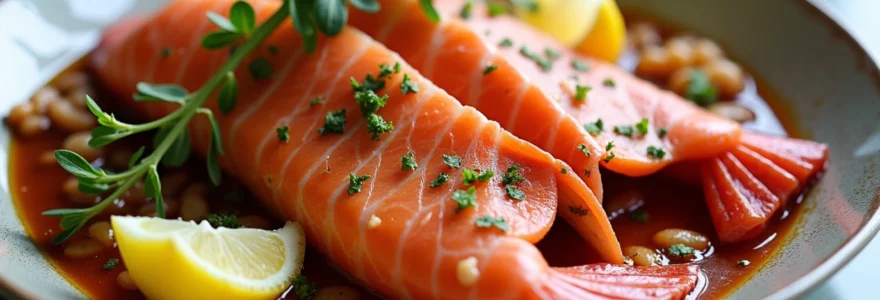Coastal destinations offer a treasure trove of culinary delights, with seafood at the heart of their gastronomic allure. From sun-kissed Mediterranean shores to the vibrant Caribbean coastlines, these regions boast an impressive array of seafood dishes that captivate the senses and celebrate local traditions. The unique flavours, textures, and aromas of freshly caught fish and shellfish create unforgettable dining experiences that transport you to the very essence of coastal living.
Culinary biodiversity of coastal ecosystems
Coastal ecosystems are teeming with an incredible diversity of marine life, providing a rich palette of ingredients for culinary creations. The interplay between saltwater and freshwater environments creates unique habitats that support a wide variety of fish, crustaceans, and molluscs. This biodiversity is reflected in the local cuisines, where each region showcases its distinct seafood specialities.
In temperate coastal areas, you’ll find an abundance of cod, haddock, and plaice, while tropical waters yield exotic species like mahi-mahi, grouper, and barracuda. Shellfish enthusiasts can indulge in succulent oysters, mussels, and clams along rocky shorelines, while sandy beaches often harbour populations of cockles and razor clams. The diversity of coastal ecosystems ensures that there’s always something new and exciting to discover on your plate.
Estuaries, where rivers meet the sea, are particularly rich in seafood variety. These brackish waters are home to species that can tolerate both fresh and saltwater, such as salmon, sea trout, and some varieties of shrimp. The unique flavour profiles of these estuarine species often become signature ingredients in local dishes, reflecting the terroir of the coastal region.
Regional seafood specialties: from mediterranean to caribbean
Coastal regions around the world have developed their own iconic seafood dishes, each reflecting the local catch and culinary traditions. These specialities not only showcase the bounty of the sea but also tell stories of cultural heritage and historical influences. Let’s explore some of the most renowned seafood dishes from various coastal destinations.
Bouillabaisse: marseille’s iconic fish stew
Originating from the port city of Marseille in southern France, bouillabaisse is a hearty fish stew that epitomises Provençal cuisine. This dish traditionally includes at least three types of fish, along with various shellfish, vegetables, and aromatic herbs. The key to authentic bouillabaisse lies in the use of Mediterranean fish like rascasse (scorpion fish), sea robin, and European conger.
The preparation of bouillabaisse is a labour of love, involving a two-step cooking process. First, a flavourful broth is created using fish bones, leeks, onions, fennel, and tomatoes. Then, the fish and shellfish are added in stages, ensuring each component is cooked to perfection. The stew is typically served with rouille , a garlicky saffron mayonnaise, and crusty bread for dipping.
Paella valenciana: spain’s coastal rice dish
While paella originated as a humble farmer’s dish in Valencia, its coastal variant has become one of Spain’s most iconic seafood dishes. Seafood paella showcases the rich bounty of the Mediterranean, typically featuring a combination of shrimp, mussels, squid, and sometimes lobster or crayfish.
The secret to a perfect paella lies in the rice, which absorbs the flavours of the seafood and the aromatic sofrito base. Saffron gives the dish its characteristic golden hue and subtle floral notes. Cooked in a wide, shallow pan over an open flame, paella develops a prized crispy bottom layer called socarrat , which adds a delightful textural contrast to the dish.
New england clam chowder: atlantic coast classic
New England clam chowder is a beloved staple of the northeastern United States, particularly in coastal towns of Massachusetts and Maine. This creamy soup features tender clams, diced potatoes, and often salt pork or bacon, all simmered in a rich, milk-based broth.
The origins of clam chowder can be traced back to the region’s fishing communities, where it provided a hearty and warming meal for fishermen returning from sea. Today, it’s served in everything from casual seafood shacks to upscale restaurants, often accompanied by oyster crackers or crusty bread. The best New England clam chowder balances the briny sweetness of fresh clams with the comforting richness of cream and potatoes.
Jerk fish: jamaica’s spicy seaside offering
Jerk seasoning, a fiery blend of Scotch bonnet peppers, allspice, thyme, and other spices, is synonymous with Jamaican cuisine. While often associated with chicken and pork, jerk seasoning also works wonders with fish, creating a vibrant and spicy seafood dish that captures the essence of Caribbean flavours.
Jerk fish typically uses firm, white-fleshed fish like snapper or mahi-mahi, which can stand up to the bold seasoning. The fish is marinated in the jerk spice mixture, then grilled over pimento wood for an authentic smoky flavour. Served with rice and peas, fried plantains, and a side of cooling coleslaw, jerk fish offers a perfect balance of heat, smoke, and tropical freshness.
Ceviche: peru’s raw fish delicacy
Ceviche, Peru’s national dish, is a testament to the country’s bountiful coastline and the ingenuity of its culinary traditions. This dish features raw fish or seafood “cooked” in citrus juice, typically lime, which denatures the proteins and gives the fish a firm, opaque appearance.
Traditional Peruvian ceviche is made with sea bass or flounder, mixed with red onions, chilli peppers, and cilantro. The acid from the lime juice not only cooks the fish but also creates a flavourful liquid called leche de tigre (tiger’s milk), which is often served alongside the ceviche. Regional variations may include sweet potato, corn, or even tropical fruits like mango or passion fruit, showcasing the diversity of Peru’s coastal cuisine.
Sustainable fishing practices and local economies
As the demand for seafood continues to grow globally, the importance of sustainable fishing practices cannot be overstated. Coastal communities, whose livelihoods depend on the health of marine ecosystems, are at the forefront of efforts to balance economic needs with environmental conservation.
Sustainable fishing practices encompass a range of methods and policies designed to maintain fish populations and preserve marine habitats. These include:
- Implementing catch limits and quotas
- Using selective fishing gear to reduce bycatch
- Establishing marine protected areas
- Promoting responsible aquaculture
Many coastal destinations are now embracing sustainable seafood initiatives, which not only help protect marine ecosystems but also add value to local economies. Restaurants and markets that prioritise locally caught, sustainably sourced seafood often attract environmentally conscious tourists and food enthusiasts.
The concept of “boat-to-table” dining has gained traction in many coastal regions, with restaurants forming direct partnerships with local fishermen. This approach ensures the freshest seafood for diners while providing fair prices for fishers. It also helps preserve traditional fishing methods and supports small-scale fishing operations that are often more sustainable than large industrial fleets.
Sustainable seafood is not just about preserving marine life; it’s about sustaining coastal communities and their cultural heritage for generations to come.
Initiatives like seafood traceability programmes and eco-certification schemes help consumers make informed choices about the seafood they purchase. These efforts contribute to the overall sustainability of coastal ecosystems while promoting responsible tourism and supporting local economies.
Seafood preparation techniques: from raw to smoked
The art of seafood preparation encompasses a wide range of techniques, each designed to highlight the unique flavours and textures of different marine species. From delicate raw preparations to complex smoking methods, these techniques reflect the culinary traditions and innovations of coastal communities worldwide.
Sushi and sashimi: japanese raw fish artistry
Japanese cuisine has elevated the preparation of raw fish to an art form through sushi and sashimi. These dishes showcase the pristine quality and natural flavours of the fish, requiring exceptional skill in selection, cutting, and presentation.
Sushi involves combining vinegared rice with raw fish, seafood, vegetables, or egg, often wrapped in nori seaweed. Sashimi, on the other hand, consists of thinly sliced raw fish or seafood served without rice. Both require impeccably fresh, sashimi-grade fish and precise knife skills to achieve the perfect texture and presentation.
The itamae (sushi chef) must master various cutting techniques, such as hira-zukuri for flat slices and usu-zukuri for paper-thin slices, each suited to different types of fish. The art of sushi and sashimi preparation also extends to the careful balancing of flavours and textures, often incorporating elements like wasabi, pickled ginger, and soy sauce to complement the fish.
Grilling methods: mediterranean Char-Grilled octopus
Grilling is a popular method for preparing seafood in many coastal cuisines, with Mediterranean-style char-grilled octopus being a prime example. This dish showcases the transformation of a potentially tough ingredient into a tender, flavourful delicacy through careful preparation and cooking.
The process typically begins with tenderising the octopus, often by freezing and thawing or by gently simmering it in water or wine. Once tender, the octopus is marinated in olive oil, lemon juice, and herbs before being quickly grilled over high heat. The result is a dish with a crispy, charred exterior and a succulent interior, bursting with Mediterranean flavours.
Grilling techniques vary across coastal regions, from the plancha (flat metal griddle) used in Spain to the braai (open-fire grill) of South Africa. Each method imparts its unique character to the seafood, often complemented by local herbs, spices, and marinades.
Smoking techniques: scottish smoked salmon
Smoking is an ancient preservation method that has evolved into a sophisticated culinary technique, particularly for seafood. Scottish smoked salmon is renowned worldwide for its rich, complex flavour and silky texture.
The traditional Scottish smoking process begins with curing fresh salmon fillets in salt, sometimes with added sugar and spices. The cured salmon is then cold-smoked over smouldering wood chips, often oak or beech, at temperatures below 30°C (86°F) for several hours or even days. This slow smoking process allows the fish to absorb the smoky flavour while retaining its delicate texture.
Different regions have developed their own smoking techniques and flavour profiles. In Scandinavia, for example, gravlax is a style of cured salmon flavoured with dill, while in North America, hot-smoking techniques produce a flakier, more fully cooked smoked fish.
Fermentation: scandinavian surströmming
Fermentation is a preservation method that has given rise to some of the most distinctive and polarising seafood preparations. Scandinavian surströmming, a fermented Baltic Sea herring, is perhaps the most infamous example.
To create surströmming, fresh herring is caught in spring, salted, and left to ferment for several months. The fermentation process produces a pungent aroma and strong, tangy flavour that is considered a delicacy in Sweden but often challenging for the uninitiated.
Other fermented seafood preparations include Korean jeotgal, a category of salted and fermented seafood used as a condiment, and Filipino bagoong, a fermented fish or shrimp paste. These fermented products not only preserve seafood but also create complex umami flavours that are integral to many coastal cuisines.
Wine and seafood pairing: coastal viticulture
Coastal regions often boast not only exceptional seafood but also unique wine-growing terroirs, creating perfect opportunities for local food and wine pairings. The influence of sea breezes, mineral-rich soils, and moderate temperatures in many coastal vineyards contributes to the production of wines that naturally complement seafood dishes.
In regions like Galicia in Spain, the Albariño grape thrives in the cool, damp climate near the Atlantic coast, producing crisp white wines with mineral notes that pair beautifully with local seafood. Similarly, the Muscadet wines from the Loire Valley in France, with their lean, saline character, are a classic match for oysters and other shellfish.
Coastal wine regions often specialise in varieties that harmonise with seafood:
- Vermentino from Liguria and Sardinia in Italy
- Assyrtiko from the Greek islands
- Riesling from coastal regions of Australia and New Zealand
- Sauvignon Blanc from Marlborough, New Zealand
These wines typically offer bright acidity, mineral notes, and subtle fruit flavours that enhance rather than overpower delicate seafood dishes. The concept of terroir extends beyond the wine itself, encompassing the entire coastal ecosystem and culinary traditions.
The best coastal wine and seafood pairings celebrate the synergy between what grows on the land and what comes from the sea, creating a harmonious expression of place on the plate and in the glass.
For those seeking to explore wine and seafood pairings , many coastal destinations offer tasting experiences that showcase local wines alongside regional seafood specialities. These pairings not only enhance the dining experience but also provide insight into the local terroir and culinary heritage.
Cultural significance of seafood festivals
Seafood festivals are vibrant celebrations that bring together local communities and visitors to honour coastal culinary traditions. These events not only showcase the region’s seafood bounty but also play a crucial role in preserving cultural heritage, supporting local economies, and promoting sustainable fishing practices.
Maine lobster festival: celebrating crustaceans
The Maine Lobster Festival, held annually in Rockland, Maine, is one of the most famous seafood festivals in the United States. This five-day event celebrates the state’s iconic lobster industry, featuring lobster dinners, cooking contests, and educational displays about lobster fishing and conservation efforts.
Beyond the culinary aspects, the festival includes parades, live entertainment, and the crowning of the Maine Sea Goddess, reflecting the deep cultural ties between the community and its maritime heritage. The event not only boosts tourism but also raises awareness about the importance of sustainable lobster fishing to Maine’s coastal economy.
Galway international oyster festival: bivalve extravaganza
Held in Galway, Ireland, since 1954, the Galway International Oyster Festival is one of the oldest oyster festivals in the world. This event celebrates the native Galway Bay oysters, which are in season starting in September. The festival features oyster opening competitions, tastings, and the World Oyster Opening Championship.
The festival showcases the cultural significance of oysters in Irish cuisine and highlights the importance of oyster farming to the local economy. It also serves as a platform for educating visitors about oyster cultivation and the environmental factors that contribute to the unique flavour of Galway Bay oysters.
Fiesta del marisco: galicia’s seafoo
d showcase
Galicia’s Fiesta del Marisco, or Seafood Festival, is a gastronomic celebration held annually in O Grove, a coastal town in northwestern Spain. This festival, which has been running for over 50 years, showcases the incredible variety of seafood found in the Rías Baixas estuaries.
The festival features cooking demonstrations, tastings, and competitions centered around local specialties like octopus, mussels, and scallops. One of the highlights is the preparation of a giant paella, often large enough to feed thousands of visitors. The event not only promotes Galician seafood but also educates visitors about the region’s fishing industry and the importance of sustainable practices.
Mussel and oyster festival: knysna’s shellfish celebration
The Knysna Oyster Festival, held in Knysna, South Africa, is a 10-day event that celebrates the town’s famous oysters and mussels. Located along the picturesque Garden Route, Knysna is renowned for its oyster farming and wild oyster picking traditions.
The festival combines culinary events with sports activities, making it a unique celebration of food and fitness. Visitors can participate in oyster shucking competitions, attend wine and oyster pairings, and enjoy a variety of seafood dishes prepared by local chefs. The event also raises awareness about the local ecosystem and the importance of sustainable aquaculture practices in the Knysna estuary.
These seafood festivals not only celebrate local culinary traditions but also play a crucial role in promoting sustainable fishing practices, supporting local economies, and preserving coastal cultural heritage. They offer visitors a unique opportunity to immerse themselves in the flavors and traditions of coastal communities while fostering a deeper appreciation for the bounty of the sea.


